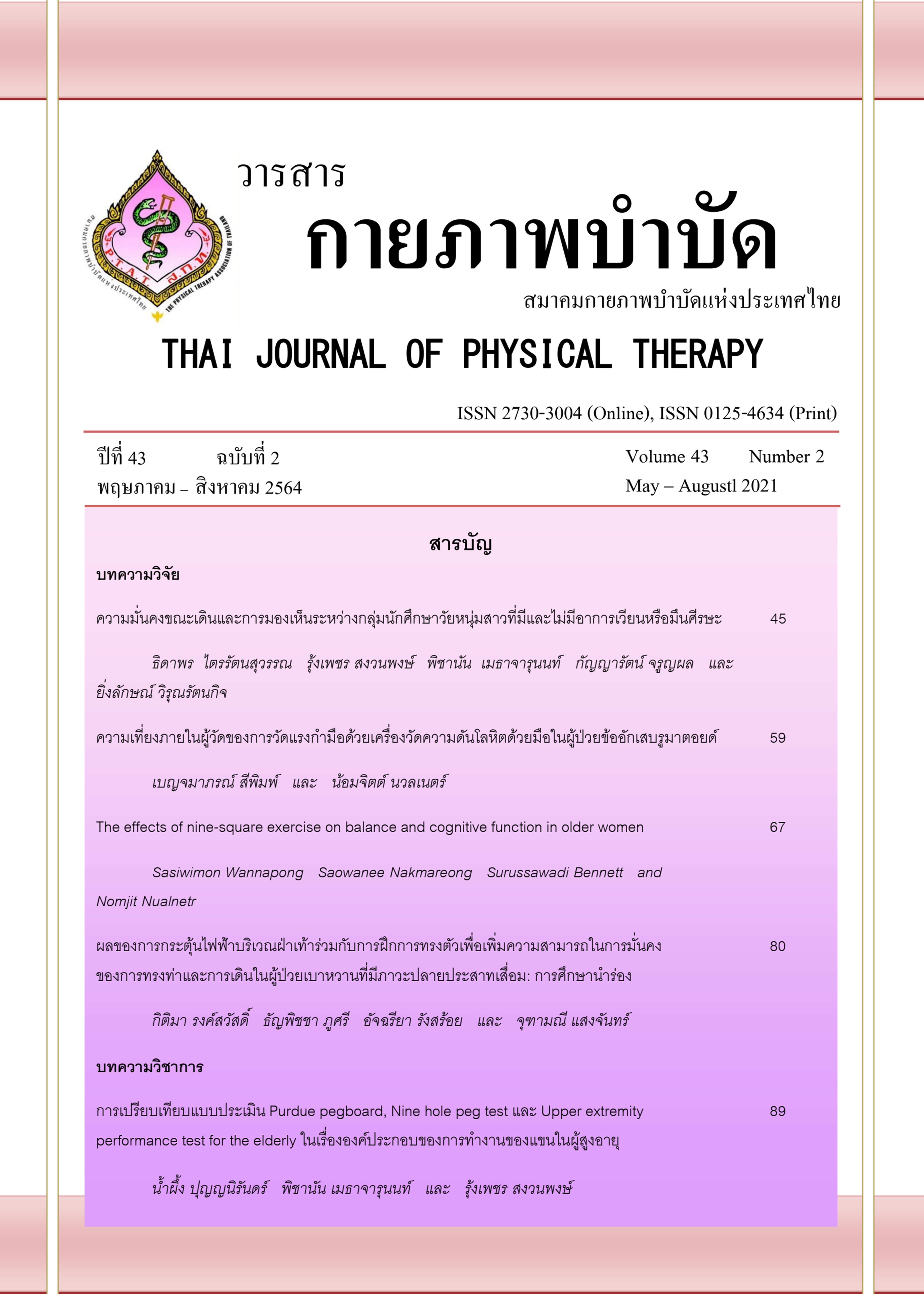ความเที่ยงภายในผู้วัดของการวัดแรงกำมือด้วยเครื่องวัดความดันโลหิตด้วยมือในผู้ป่วยข้ออักเสบรูมาตอยด์ด์
Main Article Content
บทคัดย่อ
ที่มาและความสำคัญ: การวัดแรงกำมือเป็นการตรวจประเมินทางคลินิกที่สำคัญอย่างหนึ่งเพื่อใช้ในการพยากรณ์โรคและวางแผนการรักษาแก่ผู้ป่วยข้ออักเสบรูมาตอยด์ ปัจจุบันมีการนำเครื่องวัดความดันโลหิตด้วยมือมาประยุกต์เป็นเครื่องวัดแรงกำมือ อย่างไรก็ตาม รายงานเกี่ยวกับคุณสมบัติของเครื่องมือดังกล่าวในผู้ป่วยข้ออักเสบรูมาตอยด์ยังมีจำนวนจำกัด
วัตถุประสงค์: เพื่อประเมินความเที่ยงภายในผู้วัดของการวัดแรงกำมือด้วยเครื่องวัดความดันโลหิตด้วยมือในผู้ป่วยข้ออักเสบรูมาตอยด์
วิธีการวิจัย: อาสาสมัครคือผู้ป่วยข้ออักเสบรูมาตอยด์จำนวน 89 ราย (หญิง 60 คน ชาย 29 คน) ให้อาสาสมัครใช้มือข้างที่ถนัดออกแรงกำส่วนที่ใช้พันรอบต้นแขนของเครื่องวัดความดันโลหิตซึ่งม้วนและบรรจุอยู่ในถุงผ้าอย่างเต็มที่ที่สุดและต่อเนื่องกัน 5 วินาที ผู้วิจัยบันทึกค่าแรงดันสูงสุดและคงที่ที่เกิดขึ้นในช่วงเวลา 5 วินาทีนั้น แล้วให้อาสาสมัครพักอย่างน้อย 30 วินาที จึงทดสอบซ้ำอีกครั้งหนึ่ง จากนั้นวัดแรงกำมือมือข้างที่ไม่ถนัดด้วยขั้นตอนเดียวกัน ประเมินความเที่ยงภายในผู้วัดของการวัดแรงกำมือแต่ละข้างด้วยค่าสัมประสิทธิ์สัมพันธ์ภายในกลุ่ม (ICC model 3,1) โดยกำหนดระดับนัยสำคัญทางสถิติที่ p<0.05
ผลการวิจัย: ค่าสัมประสิทธิ์สัมพันธ์ภายในกลุ่ม (ICC3,1) ของการวัดแรงกำมือดังกล่าวมีค่าเท่ากับ 0.95 (95% CI อยู่ระหว่าง 0.93 ถึง 0.97, p<0.001) และ 0.99 (95% CI อยู่ระหว่าง 0.98 ถึง 0.99, p<0.001) สำหรับมือข้างที่ถนัดและไม่ถนัด ตามลำดับ
สรุปผล: การวัดแรงกำมือด้วยเครื่องวัดความดันโลหิตด้วยมือในผู้ป่วยข้ออักเสบรูมาตอยด์ที่มีความรุนแรงของอาการในระดับปานกลางมีความเที่ยงภายในผู้วัดในเกณฑ์สูงมาก ดังนั้น เครื่องมือนี้จึงน่าจะเป็นทางเลือกหนึ่งของนักกายภาพบำบัดในการนำไปใช้วัดแรงกำมือของผู้ป่วยข้ออักเสบรูมาตอยด์ได้ จึงควรทดสอบคุณสมบัติของเครื่องมือในด้านอื่น ๆ เพิ่มเติม เพื่อสามารถนำเครื่องมือนี้ไปใช้ประโยชน์ได้อย่างกว้างขวางยิ่งขึ้นต่อไป
Article Details
เอกสารอ้างอิง
National Institute for Health and Clinical Excellence: Rheumatoid arthritis: the management of rheumatoid arthritis in adults. London: National Institute for Health and Clinical Excellence, 2009.
Fraser A, Vollow J, Preston A, Cooper RG. Predicting ‘normal’ grip strength for rheumatoid arthritis patients. Rheumatology. 1999; 38(6): 521-8.
Shipham I, Pitout SJ. Rheumatoid arthritis: hand function, activities of daily living, grip strength and essential assistive devices. Curationis. 2003; 26(3): 98-106.
Ugurlu U, Ozdogan H. Conversion of grip strength scores between Jamar dynamometer and a modified sphygmomanometer in patients with rheumatoid arthritis. Isokinet Exerc Sci. 2013; 21(4): 263-72.
Pujianita L, Prabowa T, Prananta MS. Prediction of Jarmar grip strength value using modified aneroid sphygmomanometer cuff method. Int J Integr Health Sci. 2017; 5(1): 1-7.
Souza LAC, Martins JC, Moura JB, Teixeira-Salmela LF, De Paula FV, Faria CDCM. Assessment of muscular strength with the modified sphygmomanometer test: what is the best method and source of outcome values?. Braz J Phys Ther. 2014; 18(2): 191-200.
Martins JC, Teixeira-Salmela LF, Souza LAC, Aguiar LT, Lara EM, Moura JB, et al. Reliability and validity of the modified sphygmomanometer test for the assessment of strength of upper limb muscles after stroke. J Rehabil Med. 2015; 47(8): 697-705.
Tansakul P, Panuwannakorn M. Grip strength in normal population and rheumatoid arthritis patients: comparison of sphygmomanometer and hydraulic dynamometer. J Thai Rehabil Med. 2007;17(3): 86-90.
Bastiana YD, Tulaar ABM, Hartono S, Albar Z. Effect of range of motion and isometric strengthening exercises on grip strength and hand function in rheumatoid arthritis patients. Univ Med. 2008; 27(8): 157-64.
Khiewyoo J. Statistical methods for health measurement. Khon Kaen: Klang Na Na Vithaya, 2014.
Portney LG, Watkins MP. Foundations of clinical research: applications to practice. 2nd ed. Upper Saddle River: Prentice-Hall, 2000.
Bonett DG. Sample size requirements for estimating intraclass correlations with desired precision. Statist Med. 2002; 21(9): 1331-5.
Breedland I, Scheppingen C, Leijsma M, Jansen N, Weert E. Effects of group-based exercise and educational program on physical performance and disease self-management in rheumatoid arthritis: a randomized controlled study. Phys Ther. 2011; 91(1): 879-93.
Farheen K, Agarwal SK. Assessment of disease activity and treatment outcomes in rheumatoid arthritis. J Manag Care Pharm. 2011; 17(9 Suppl B): S09-13.
Hamilton GF, McDonald C, Chenie TC. Measurement of grip strength: validity and reliability of the sphygmomanometer and Jamar grip dynamometer. J Orthop Sports Phys Ther. 1992; 16(5): 215-9.
Hillman TE, Nunes QM, Hornby ST, Stange Z, Neal KR, Rowlands BJ, et al. A practical posture for hand grip dynamometry in the clinical setting. Clin Nutr. 2005; 24(2): 224-8.
Domholdt E. Physical therapy research. 2nd ed. Philadelphia: W.B. Saunders, 2000.


